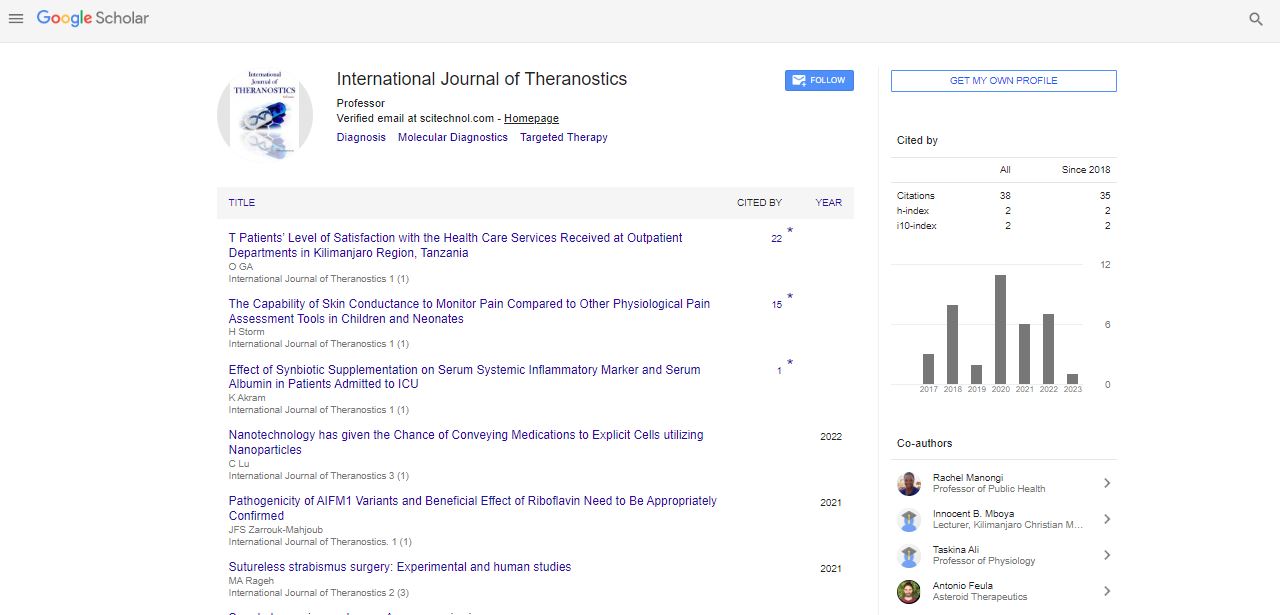Perspective, Int J Theranostics Vol: 3 Issue: 2
Production and Analytical Validation of a Theranostic Pair
Martyna Zaleska*
Department of Cardiology and Hypertension, Central Research Hospital, The Ministry of the Interior, Mazovia, Poland
*Corresponding Author: Martyna Zaleska
Department of Cardiology and Hypertension, Central Research Hospital, The Ministry of the Interior, Mazovia, Poland
E-mail: zaleskamartyna@gmail.com
Received date: 14 March, 2022; Manuscript No. IJT-22-56274;
Editor assigned date: 16 March, 2022; PreQC No. IJT-22-56274 (PQ);
Reviewed date: 28 March, 2022; QC No. IJT-22-56274;
Revised date: 07 April, 2022; Manuscript No. IJT-22-56274 (R);
Published date: 15 April, 2022; DOI:10.4172/Ijt.1000113
Citation: Zaleska M (2022) Production and Analytical Validation of a Theranostic Pair. Int J Theranostics 3:2.
Keywords: Theranostics
Description
Persistent venous infection is regularly neglected by essential and cardiovascular consideration suppliers in light of an under enthusiasm for the greatness and effect of the issue. The significance of constant venous illness is connected with the quantity of individuals with the infection and the financial effect of its more serious indications. Sadly, the writing concerning the commonness and frequency of persistent venous illness has shifted significantly due to contrasts in the strategies for assessment, measures for definition, and the geographic locales broke down. The most well-known appearances of persistent venous sickness are enlarged cutaneous veins, for example, telangiectasia and reticular veins, and varicose veins. The term persistent Venous Inadequacy (CVI) depicts a condition that influences the venous arrangement of the lower furthest points with venous hypertension causing different pathologies including torment, enlarging, douche, skin changes, and ulcerations. Albeit the term CVI is frequently used to reject simple varicose veins, varicose veins have uncouth valves with expanded venous strain prompting moderate widening and convolution. We will utilize the term CVI to address the full range of appearances of ongoing venous illness. Varicose veins essentially affect medical services assets, with a great many individuals looking for clinical consideration for their restorative appearance every year. Albeit frequently limited, the corrective outcomes may antagonistically influence a singular's personal satisfaction and are related with different appearances.
Puncturing Veins Additionally
Difficulties of removal in youngsters are significantly less serious than in grown-ups. The first of these lower-furthest point valves is normally situated in the normal femoral vein or less generally in the outer iliac vein. The recurrence of venous valves increments from the proximal to the distal leg to forestall an expansion in tension inside the distal veins coming about because of the impacts of gravity.
Puncturing veins additionally contain one-way valves that keep reflux of blood from the profound veins into the shallow framework. The valves work working together with venous muscle siphons to permit the arrival of blood against gravity to the heart. Compression of the muscle siphons principally in the calf, yet in addition in the foot and thigh, and powers blood out of the venous plexus and up the profound venous framework on account of expanded tension inside the facial compartments. The valve framework keeps blood from being constrained distally inside the profound venous framework or through the perforator framework into the shallow framework. Venous pathology creates when venous strain is expanded and return of blood is hindered through a few components. With disappointment of the valves of the profound veins, typical blood volume is siphoned out of the limit, however top off happens by both blood vessel inflow and neurotic retrograde venous stream. Brokenness or inadequacy of the valves in the shallow venous framework additionally permits retrograde progression of blood and expanded hydrostatic tensions. Valve disappointment might be essential the consequence of prior shortcoming in the vessel divider or valve flyers, or auxiliary to coordinate injury, shallow phlebitis, or unnecessary venous distension coming about because of hormonal impacts or high strain. Disappointment of valves situated at the intersections of the profound and shallow frameworks, most eminently at the saphenofemoral and saphenopopliteal intersections, permits high strain to enter the shallow veins. In the present circumstance, venous dilatation and varicose veins structure and proliferate from the proximal intersection site down the furthest point. Perforator valve ineptitude permits blood to move from profound veins in reverse into the shallow framework and the transmission of the great tensions produced by the lower leg muscle siphon. This nearby high strain can create unreasonable venous dilatation and optional disappointment of shallow vein valves. Accordingly, a group of expanded veins creates at this site and seems to rise up the leg. Discontinuity and annihilation of microlymphatics may additionally disable seepage from the limit, though brokenness of neighborhood nerve filaments might modify administrative systems. Another hypothesis includes the catching of white platelets in the vessels or post capillary venues. The bond of white platelets with initiation discharges incendiary go between and proteolysis compounds with endothelial harm that might increment penetrability or hinder stream prompting impediment. The profound veins of the lower limit comprise of hub veins, which follow the course of the significant corridors, and intramuscular veins, including venous sinusoids and plexus. The puncturing veins navigate the anatomic facial layer to associate the shallow to the profound venous framework. The recurrence of these venous valves increments from the proximal to distal leg to forestall an expansion strain inside the distal veins on account of gravitational impacts. Furthermore, puncturing veins likewise contain valves that just permit blood stream from the shallow to the profound veins. The valves keep blood from being constrained all the more distally inside the profound framework or through perforator veins into the shallow framework.
 Spanish
Spanish  Chinese
Chinese  Russian
Russian  German
German  French
French  Japanese
Japanese  Portuguese
Portuguese  Hindi
Hindi 